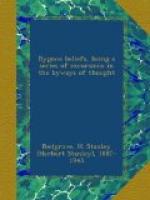[1] I think, however, that these, and many similar stories, must be taken cum grano salis.
In conclusion, mention must be made of a very interesting and suggestive philosophical doctrine—the Law of Correspondences,—due in its explicit form to the Swedish philosopher, who was both scientist and mystic, EMANUEL SWEDENBORG. To deal in any way adequately with this important topic is totally impossible within the confines of the present discussion.[2] But, to put the matter as briefly as possible, it may be said that SWEDENBORG maintains (and the conclusion, I think, is valid) that all causation is from the spiritual world, physical causation being but secondary, or apparent—that is to say, a mere reflection, as it were, of the true process. He argues from this, thereby supplying a philosophical basis for the unanimous belief of the nature-mystics, that every natural object is the symbol (because the creation) of an idea or spiritual verity in its widest sense. Thus, there are symbols which are inherent in the nature of things, and symbols which are not. The former are genuine, the latter merely artificial. Writing from the transcendental point of view, ELIPHAS LEVI says: “Ceremonies, vestments, perfumes, characters and figures being . . .necessary to enlist the imagination in the education of the will, the success of magical works depends upon the faithful observance of all the rites, which are in no sense fantastic or arbitrary, having been transmitted to us by antiquity, and permanently subsisting by the essential laws of analogical realisation and of the correspondence which inevitably connects ideas and forms."[1b] Some scepticism, perhaps, may be permitted as to the validity of the latter part of this statement, and the former may be qualified by the proviso that such things are only of value in the right education of the will, if they are, indeed, genuine, and not merely artificial, symbols. But the writer, as I think will be admitted, has grasped the essential point, and, to conclude our excursion, as we began it, with a definition, I will say that the power of the talisman is the power of the mind (or imagination) brought into activity by means of a suitable symbol.




